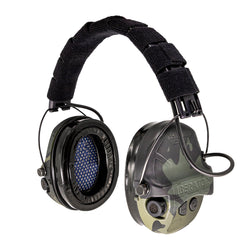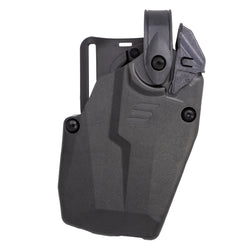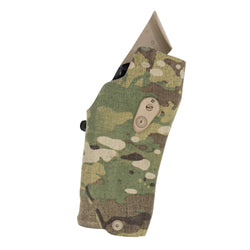The Cold War lasted from 1947 to 1991, and calling it cold is a bit deceptive. In those 44 years, there were plenty of hot, interesting conflicts between the Western and Eastern worlds.
This era pushed an arms race unlike any other. Nuclear weapons became standard amongst world powers. Fighter planes turned into jets, bombers became stealthy, and the military changed rapidly.

In the face of nuclear weapons and stealth bombers, a handgun seems inconsequential. But not to us! Today, we are diving into the Top Handguns of the Cold War.
If I compiled a complete list of handguns fielded during the Cold War, we’d be here all day. Instead, we’re focusing on the few that defined the Cold War—those that served major military powers or were notable influences around the world.
Handguns are a small part of warfare, especially when it comes to a so-called Cold War, but if you prefer on-the-ground history, you’ve come to the right place.
The Most Influential Cold War Handguns
Colt M1911
The Colt M1911 served from 1911 to 1985, which covered almost the entirety of the Cold War. In fact, you could argue its continued use with Special Operations forces after its official replacement meant its service spanned the conflict entirely, from before to well after.
John Browning designed the M1911 expressly for the U.S. Army, which was looking to transition from a revolver to a semi-automatic design. Its famed .45 ACP chambering was also designed for the U.S. Army. The M1911 would be immensely successful not just in the military but also with police forces and civilians.

The 1911 used John Browning’s short recoil principle to allow for reliable operation and manageable recoil. It’s a single-action-only, hammer-fired design that utilizes a removable box magazine. This magazine originally held seven rounds of .45 ACP, but later expanded into eight and nine-round capacities.
The M1911 saw continuous action through its lengthy career and became John Browning’s most successful creation. While it served primarily with American forces, the pistol was adopted worldwide. American allies like the Philippines still field the M1911, and even the Soviet Union received some units during the World Wars. The M1911 was the defining pistol of American forces during the Cold War and remains one of our best exports into the world of firearms.
The Browning Hi-Power
John Browning never finished his famed Hi-Power pistol, but Belgian designer Dieudonné Saive stepped in to deliver a pistol that would become a Cold War Icon. The Hi-Power series of pistols would be used before, after, and during the Cold War by countless military forces around the world.
Canada, the United Kingdom, Denmark, Greece, the Netherlands, and many more fielded the gun amongst Western forces. Hi-Powers, or clones of Hi-Powers, found their way to North Korea, Vietnam, and the Soviet Union during various conflicts. It was a pistol with a full passport.

The Hi-Power was a semi-automatic 9mm pistol, and it gained its name and fame from its use of a staggered column magazine. This gave the gun 13 rounds of 9mm compared to the typical eight or nine rounds you’d find in a single-stack design. The name “Hi-Power” was a reference capacity more than the caliber.
The Hi-Power made use of Browning’s short recoil system for a reliable, low-recoil action. Much like the M1911, the gun utilized a single-action-only, hammer-fired design and it shared a reputation for accuracy, reliability, and excellent ergonomics.
Makarov Pistol
In 1951, the Soviet Union decided the dated TT-33 needed replacement and modernization. The new sidearm project was led by Nikolay Fyodorovich Makarov, and the pistol the project created would bear his name.
The Makarov would be a fairly simple and stout pistol, taking several design cues from the Walther series of pistols. It was a straight blowback design that used a DA/SA action with a safety that doubled as a decocker.
To accommodate the straight blowback design, the gun used a 9.2mm cartridge that became known as 9mm Makarov. This pistol and cartridge formed the basis of Soviet handgun design, and the design is still fielded to this day.

Unsurprisingly, the Makarov pistol spread like wildfire. Numerous Soviet-aligned countries adopted the pistol, with many, including East Germany, Bulgaria, China, Vietnam, and North Korea, producing local variants. The Soviets themselves even designed several variants of the Makarov, including a suppressed version and a modernized variant with a 12-round magazine.
The Makarov is known to be reliable, but somewhat crude. The double-action trigger is atrociously long, the recoil fairly snappy, and the gun’s compact design seems somewhat odd for a military firearm.
Walther PP Series
The Walther PP series predates the Cold War but has also remained in production long after it ended. Numerous military forces used the Walther PP and PPK before and during the Cold War, but its biggest contribution to the Cold War was its design.
The Walther PP series established a unique layout and feature set that would be widely copied, especially by Warsaw Pact countries. Key features included:
- Blowback Operation
- Fixed Barrel That Doubled As a Recoil Spring
- Double Action/Single Action Operation
- Slide-Mounted Safety/Decocker
- Single Stack Magazine

This overall design would be copied to create the Makarov, but that’s not all. The following is only a partial list of other Cold War-era pistols inspired by the Walther PP series:
- Romanian Pistol Carpați Md. 1974
- Chinese Type 64
- FEG PA-63
- German/Swiss SIG Sauer P230
- Czech VZ50/70
The PP isn’t your typical combat pistol, but it had a direct impact on the Cold War. The Walther series was fielded by British forces during the Cold War, specifically with intelligence agencies and special operations. American forces used suppressed Walthers in Vietnam in limited numbers.
Tokarev TT-33
The TT-33 is another Russian firearm, specifically the semi-auto that predated the Makarov series. The TT-33 was introduced in 1933, well before the Cold War got warm. The Soviet Union was modernizing its military forces and wanted to replace the Nagant revolver with a semi-auto.
The Russians essentially smashed together two of John Browning’s most successful designs. It looks a lot like the FN M1903, but features the short-recoil operation of the M1911. It’s a single-action-only, hammer-fired handgun.
Famously, it lacks a safety, and the prescribed carry method was a round loaded with the hammer on half-cock. The TT-33 used the potent and powerful 7.62x25mm Tokarev—a hard-hitting, fast-moving round famed for its penetration.

Even though the Soviets replaced the TT-33 in 1951, it remained in service with the Soviet Union for years after. More importantly, it was a gun widely fielded by dozens of Soviet-aligned countries around the world.
Numerous Warsaw Pact countries produced the gun domestically, including Bulgaria, Romania, Yugoslavia, Poland, and Latvia. China, North Korea, and Vietnam also produced the gun, as did Egypt, Uganda, Zimbabwe, and many, many more. It’s easy to compare the TT-33 to the Hi-Power in terms of how widespread the design was during the Cold War.
Handguns Of The Cold War
Handguns during the Cold War experienced an interesting evolution. We saw the tail end of mass revolver usage transform into the age of the semi-auto handgun. Then we watched those single-action, single-stacks turn into double-action, double-stacks and into the modern handguns we see today.









